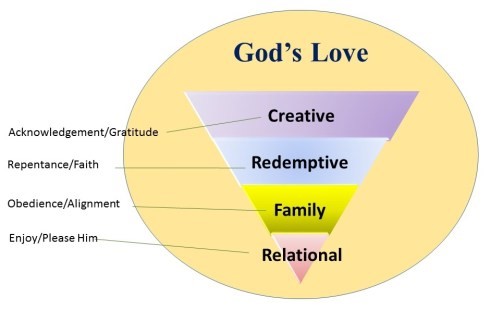God’s Love Language

“Love the Lord your God with all your heart, mind, and strength,” was the answer Jesus gave to the question, what is the greatest commandment? But what does loving God look like? Is it simply having positive thoughts or feelings about God? Can we choose how to love God?
Our love for God begins with God’s love for us. I have observed four specific expressions of God’s amazing love that take us deep into His heart. A cut diamond refracts light to reveal an array of colors. In the same way, as the white light of God’s love touches the prism of broken humanity, the hidden colors are revealed. The primary colors of God’s love could be called
- His creative sustaining love
- His individual redemptive love
- His covenant family love
- His relational intimate love
I believe God desires a fitting love response for each of His love expressions. Author Gary Chapman describes five “love languages” through which people express and experience love. I suggest that we need to respond to God according to His “love language.”
Each of these expressions of God’s love is an outgrowth of His grace. We do not and cannot earn any of them. However, we do not automatically experience them. Experiencing each of these expressions of love depends on our response to it. We are as close to Christ as we choose to be.
The broadest expression is God’s creative sustaining love. God gives it without requiring any merit or condition. The evidence of this love is all that He has created. Even those who reject God receive the benefits of this love. The Apostle Paul identified the proper response to creative sustaining love as reverence and gratitude (Romans 1).
We find a deeper relationship through His individual redemptive love. In this, He releases people from captivity to the domain of darkness into the kingdom of light (Colossians 1:13-14). We see this love in the first part of John 3:16, “For God so loved the world. . . .” To experience this love, we must repent and believe in the gospel (John 3:16, Mark 1:15).
We find the next expression of God’s love, His covenant family love, in our new identity as children of God (John 1:12, 1 John 3:1-3). God expresses His family love through gifts including justification, adoption, citizenship, and the indwelling of the Holy Spirit. He expects us to respond to this expression of love with a life of obedience and alignment with His will (John 14:21).
The relational intimate love of God adds another even deeper, more personal, and dynamic level of relationship. This expression of love is the continued revelation of Himself as we walk in Him (Colossians 2:6). This is the love expression that Jesus talks about with His disciples in the upper room discourse:
If you keep My commandments, you will abide in My love; just as I have kept My Father’s commandments and abide in His love. . . . You are My friends if you do what I command you. No longer do I call you slaves, for the slave does not know what his master is doing; but I have called you friends, for all things that I have heard from My Father I have made known to you.
JOHN 15:10-15, NASB, emphasis added
This “friendship” love, which was now part of the disciples’ experience, wasn’t automatic. It came through their continued alignment with Jesus and His kingdom, resulting in greater exposure to the heart and mind of God in Christ.
I think this deeply personal and relational love expression is what Jesus was asking for in John 17:26 (NASB): “I have made Your name known to them, and will make it known, so that the love with which You loved Me may be in them, and I in them.”
The offer of this expression of His love is humbling, even overwhelming to me, yet it is amazingly what God desires us to discover. It is what our soul looks for, but in all the wrong places.
The natural response to this intimate love of God is simply to enjoy His person and presence. It was what Mary was commended for in Luke 10: “Mary, who sat before the Master, hanging on every word he said” (MSG). It is a response of affection that desires God even without His blessings. Habakkuk expressed it this way:
Though the fig tree should not blossom and there be no fruit on the vines, though the yield of the olive should fail and the fields produce no food, though the flock should be cut off from the fold and there be no cattle in the stalls, yet I will exult in the LORD, I will rejoice in the God of my salvation.
HABAKKUK 3:17-18, NASB
We are called to experience and reflect the white light of God’s love, as it is split into its various colors, on the resurrection side of the cross.
Experiencing the increasing depth of God’s iridescent love reminds me of the Russian Matryoshka (nesting) dolls. Each time an outer doll is removed, another doll is revealed deeper within. Each time we experience one expression of His love, the opportunity for an even deeper one is presented.
Understanding God’s iridescent love is the privilege of discipleship. It demonstrates the value and delight He finds in each of us as He looks through our brokenness to the person we are in Christ: the person He created . . . redeemed . . . adopted . . . and calls by name. This amazing and wonderfully complex love of God invites us into a timeless relational journey called eternal life (John 17:3).
About the Author


